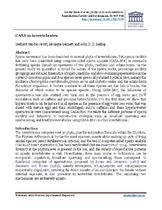| dc.description.abstract | Sperm movement has been described in several phyla of invertebrates. Yet, sperm motility has only been
quantified using computer-aided sperm analysis (CASA-Mot) in externally fertilising species (broadcast spawners) of two
phyla, molluscs and echinoderms. In the present study we quantified in detail the nature of the sperm tracks, percentage
motility groupings and detailed kinematics of rapid-, medium- and slow-swimming spermatozoa in the oyster Crassostrea
gigas and four species never previously studied by CASA-Mot, namely the molluscs Choromytilus meridionalis, Donax
serra and Haliotis midae and the echinoderm Parechinus angulosus. A feature common to all these species are the helical
tracks, the diameter of which seems to be species specific. Using CASA-Mot, the behaviour of spermatozoa was also
studied over time and in the presence of egg water and Ca2+
modulators such as caffeine and procaine hydrochloride. For
the first time, we show that hyperactivation can be induced in all species in the presence of egg water (sea water that was
mixed with mature eggs and then centrifuged) and/or caffeine, and these hyperactivated sperm tracks were characterised
using CASA-Mot. We relate the different patterns of sperm motility and behaviour to reproductive strategies such as
broadcast spawning and spermcasting, and briefly review studies using CASA-Mot on other invertebrates. | en_US |

